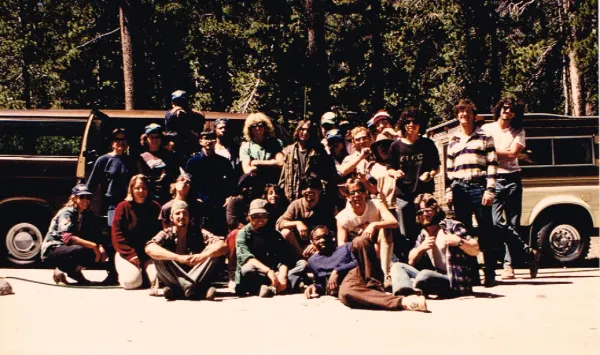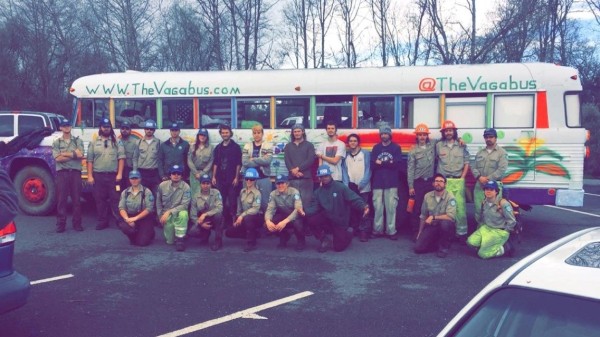Today’s post is an alumni piece written by former Fortuna Corpsmember Steven Jeffares.
Conservation can mean more than the attempts to keep certain plant and animal species, as well as ecosystems, alive. The subtle lesson often ignored which should be quite apparent points to conservation in helping us see if we really have the will to secure or change our environment, or even the world in general. People often see this as an over-generalization, or even a false hope, so they can confine themselves to their own misguidedness, but the more that we treat the world better, the more we are comfortable with ourselves and are willing to accept ourselves as humans.
I was often pressured by an older sibling who had previous positive experiences within the California Conservation Corps to join the CCC even well before I was old enough to join. I often thought of it as a social challenge to me, therefore was very against the idea. I feel maybe some others have had this dilemma. Other people might be on the fence in deciding whether to join the California Conservation Corps to pursue some kind of self-strengthening or whether to dismiss it entirely as “just another job”.
I was not someone who had an easy life with a vast fortune of wealth or happiness just given to me. Like many of you, I’ve had many problems to deal with on my own. I’ve had to grapple with reality in terms of what I wanted to do in life and what others had wanted me to do.
Such concepts are very necessary to survival in this world, and it is a forgotten will to live that keeps us sane. Rather, I have never known such a drive to keep going existed. I went in the CCC thinking of it as another job; you wake up, eat breakfast then make lunch and go to work. Well, at least when I went in it seemed to be just another job. Until…
Until I found myself doing things I have never even imagined of doing. I am not going to lie—some of these things may have seemed mundane or tedious at the time, but what I know now has encouraged me as a human being and as one who cares about the world around me. Again, not easy at times…
However, I ended up joining the California Conservation Corps not really knowing what was going to happen. A week of classes passes by fast, and before you know it, you’re out on what is referred to as ‘the grade’. On the grade, you are asked to perform numerous tasks, including a lot of work with trails, invasive species, and within the region I was stationed also helped to restore salmon habitats through rebuilding log structures in creeks. On the way, I made many friends and superiors that I deeply appreciated. My C-1 (the BOSS) helped me through various emotional challenges that were presented throughout my job. Sometimes I saw it as being pushed into a mentality, but then I’d soon learn after that these lessons were sometimes the best way to deal with certain events that would pop up through future jobs and experiences.
As for the actual work, as I have mentioned before, I performed various tasks. I had to remove invasive species from the environment. In my northern California area, this pertained to Ammophila Arenaria (A.K.A. European Dune Grass) and Hedera Helix (A.K.A. English Ivy) mostly, though I also was instructed to eradicate other plants such as Cortaderia Selloana, commonly known as Pampas Grass. During the summer I was also asked to trade the comfort of my apartment for two weeks for Fire Camp Support in Anderson. This began a very emotional high tide for me, and I swam back way stronger. Nobody was fired from our crew, and we received a very positive review for our efforts while aiding California Department of Forestry and Fire. Also, we were asked to thin out forests of certain tree species that would encroach on not-as-rapidly growing trees and performed “Fuel Reduction”, which assisted in preventing fires from spreading to areas where people worked or lived.
One of the more exciting duties I had performed in the CCC was Salmon Restoration. I loved it. Never had I actually felt like I was a part of a mechanism to help something other than myself or my friends. I had truly enjoyed watching those baby salmon swim as hard as they could as I grinded away trying to move Redwood logs into the creeks to create shelter and to help “scour” dirt away; thus creating cooler water for the salmon. This, and removing Ammophila for the Snowy Plovers, created a strong will in me to look past myself. Even writing this, it’s hard not to cry. I believe this had a huge impact on my life and how I began to view myself as a living thing, with factors as any other.
Another great aspect, and this is something I’ve heard is a common task within the distinct regions of the CCC, is trail work. It’s the job that everyone always talks about. Everything is involved with this: Grubbing, Hedging, Pruning, and Chainsaws. It always seemed to me a lot of people wished for these jobs, and during my time I was very honored to get to be able to work with National Park Service, who encouraged me to further pursue a job working on trails. Unfortunately in my case I have sustained various tears and fractures to my ankles and my feet and am unable to perform that work anymore, at least until this gets better. It should be noted that none of these were work related, and the C.C.C. was compliant with allowing time off for me to recover, and my C-1 was very understanding of these injuries and would not push me past my limits. I would heavily encourage that work, because trust me, it is much, much better than a lot of jobs you could be working.
Keeping our local environment can mean more than attempting to keep certain species and ecosystems alive. As we live, change, and grow, I suggest that we all keep this in mind. I may have not been able to continue with this type of work due to injuries, but I always encourage others to do so. If I didn’t have these, you bet I’d be working with trails or preserving the nature around us. However, even if you are injured, there are other options. I, for one, had volunteered for the wildlife center for Humboldt County and felt it just as rewarding as the Conservation Corps. I was not asked to do much physical labor, though I did do some out of my own will. You can always find something to help yourself and the people around you, let alone the world. I think the main point is: with programs like the CCC, we’re going beyond ourselves.
Steven Jeffares
Corpsmember of 2014-2015



















